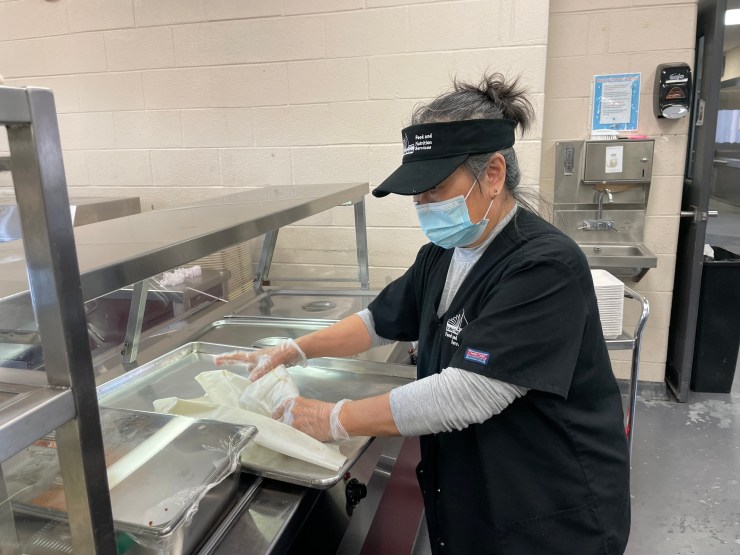
Everyone’s got an opinion on proposed USDA nutrition standards for schools — especially the students
Everyone’s got an opinion on proposed USDA nutrition standards for schools — especially the students

There were some eye rolls from eighth graders at Margaret Brent Middle School in rural St. Mary’s County, Maryland, at the side dish cafeteria worker Chunmei Fletcher offered to go with the main of PB&J, fish sandwich or pepperoni pizza.

“How about sweet potatoes?” asked Fletcher.
She even switches to Mandarin to convince one student, telling him, try them, they’re sweet.
Current USDA rules say students must take at least one fruit or vegetable with lunch. The kids are used to it, even if they don’t necessarily want to try it. More changes could be coming to school meals.
The USDA is now taking comments on proposed changes that include reducing the amount of sodium in school meals, limiting added sugar and prioritizing whole grains. The idea is to keep kids healthy and to help them develop a taste for healthier food.
Nothing in the new rules would take effect until fall 2024, but there’s already pushback: Some manufacturers say these changes will make the food more expensive to produce. And many school nutrition directors say they don’t have the labor or funding to meet the proposed standards, which don’t automatically come with higher government reimbursements to defray the costs.
One of the concerned nutrition directors is Megan Doran, who leads food nutrition services here in St. Mary’s County. Doran is worried that kids won’t eat the new food and will go hungry, which will affect their health and ability to learn.
“My fear is that our most vulnerable population — our free and reduced students — they’re not even going to want to eat the food. And they’re the ones that really need it,” said Doran.
It would also affect the way she budgets. “If the kids aren’t eating, then we have to cut labor. We have to cut costs, and that essentially would mean, possibly letting some staff go, changing our menus to meet those cost standards.”
On top of that, Doran is worried that food made to the new standards will cost more and that she won’t have the staff to make more items in-house.
“For us, with labor, you can’t do a lot of scratch cooking,” Doran said.
Doran is a member of the nonprofit School Nutrition Association. This national group for school nutrition professionals is advocating to maintain the standards already in place (or set to go into place soon) around sodium, whole grains and added sugar.
Food manufacturers are worried toom, including J.T.M. Food Group, which sells products like macaroni and cheese and taco filling to more than 10,000 districts around the country. (St. Mary’s in southern Maryland is a client.)
Brian Hofmeier, vice president of education and governmental sales for J.T.M., said that in order to meet the proposed sodium reduction, the company would rely more on potassium chloride. But he said it already costs him more than regular salt and it’s in limited supply.
“Which means that items that we manufacture for schools are going to cost even more money than they do today,” Hofmeier said.
Hofmeier also said many products made to the new standards won’t taste as good. So J.T.M. might cut back what it makes for the K-12 market, even though it represents over 40% of its business.
“I’m not going to make and sell product that people don’t like. I mean, I’m just not going to,” Hofmeier said.
The USDA isn’t worried that kids won’t eat the healthier options. Cindy Long, the agency’s administrator for Food and Nutrition Service, cites past experience with menu changes.
“I’ve heard so many stories over the years about kids going home and asking their parents about, ‘Oh, my gosh, we have this thing called kiwi. Can we try that?’” Long said.
There’s research that finds that kids who eat both breakfast and lunch at school get about half their calories there. “What’s at stake is putting kids on a path toward a healthy life or not,” Long said.
As of this week, the USDA has received more than 70,000 comments about the proposed standards for school meals.
St. Mary’s middle schoolers have ideas for one change they’d like to see: bigger pizzas. “That circle one is not big enough,” said one. “The bigger the better,” added another.
When asked if they’re always hungry, they answered in unison, “Yes!”
The proposed USDA changes are meant to both feed those hungry kids now and also change the way the next generation eats. To this end, the agency is open to more feedback: It’s taking comments until May 10.
There’s a lot happening in the world. Through it all, Marketplace is here for you.
You rely on Marketplace to break down the world’s events and tell you how it affects you in a fact-based, approachable way. We rely on your financial support to keep making that possible.
Your donation today powers the independent journalism that you rely on. For just $5/month, you can help sustain Marketplace so we can keep reporting on the things that matter to you.

















